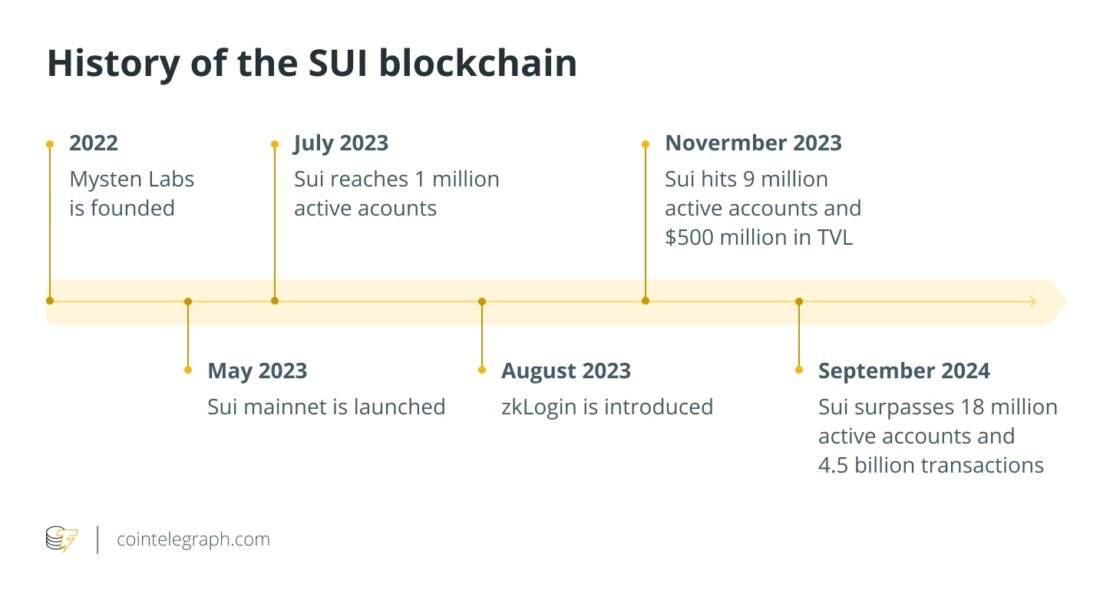What is the Sui network?
The Sui network is a novel blockchain platform designed to tackle industry challenges such as scalability, speed and cost.
Launched in May 2023 by Mysten Labs, a company founded by former Meta engineers involved in Facebook’s Diem project (formerly known as Libra), Sui was built to deliver a decentralized solution capable of processing a high volume of transactions with minimal delay.
One of Sui’s standout features is its parallel transaction processing. While similar technology is used by other networks like Solana and Avalanche, Sui distinguishes itself by reducing the complexity of coordination between validators.
This streamlined approach makes the network more efficient and scalable, allowing it to maintain high throughput even under heavy traffic without the bottlenecks that typically affect other blockchains.
As part of this, Sui introduces an object-centric model. This doesn’t just allow for more granular transaction processing; it also allows digital assets to evolve and change over time rather than remain static.
This makes the platform ideal for applications involving non-fungible tokens (NFTs), GameFi and decentralized finance (DeFi), where assets frequently need to be updated or modified. In comparison, blockchains like Solana and Avalanche are optimized for speed but lack this kind of flexibility in handling dynamic data.
Indeed, as of September 2024, Sui has seen remarkable growth, boasting over 18.19 million active accounts and having processed more than 4.58 billion transactions. These figures highlight the strong adoption of Sui among developers and users, particularly for decentralized applications (DApps) that demand both high performance and low latency.
The core technology behind the Sui blockchain
Sui’s core technologies, including its innovative Move programming language, advanced parallel transaction processing and delegated proof-of-stake (DPoS) consensus mechanism, make it a highly scalable and efficient blockchain.
Architecture and consensus mechanism
Sui’s architecture relies on its Move programming language, which was initially developed for the Diem blockchain.
Move enables the creation of smart contracts and digital assets in a more flexible and securer way compared to other popular languages such as Solidity (used by Ethereum). This is what makes it ideal for gaming, DeFi and NFTs that require assets to change states without being bogged down by the typical transaction bottlenecks.
At its core, Sui uses a delegated proof-of-stake (DPoS) consensus mechanism. This mechanism allows users to stake their Sui tokens to support validators, who are responsible for verifying and processing transactions. More on that later.
Did you know? The Move programming language was specifically designed to prioritize resource ownership and security, making it particularly resistant to common vulnerabilities like reentrancy attacks. This focus on asset ownership within the language itself ensures that digital assets are managed more securely.
Technologies supporting scalability and efficiency
Sui’s take on parallel transaction processing is one of its most innovative technologies. Sui has been tested to handle up to 297,000 transactions per second (TPS), which far surpasses the capacities of other blockchains, such as Solana, Avalanche and Polkadot, that enable parallel transaction processing.
Additionally, Sui employs a novel transaction sharding method, where different transactions are processed by distinct validators across the network. In short, this method allows the blockchain to handle workloads more efficiently, as the tasks are distributed across the network, reducing the risk of congestion and ensuring that transaction fees remain low even under high demand.
Ensuring security and low latency
To maintain low latency, Sui uses an optimized consensus engine called Mysticeti, which significantly reduces the time to finality for transactions.
In blockchain terms, “finality” refers to the point at which a transaction is considered irreversible. Sui’s consensus design enables sub-second finality, which is crucial for applications where speed is essential, such as gaming or high-frequency DeFi trading.
Security is bolstered through several layers of protection. The network’s object-centric model allows developers to code more secure smart contracts by limiting attack vectors typically associated with blockchain platforms. Additionally, Sui’s DPoS mechanism ensures that validators are incentivized to act in the network’s best interest, and any malicious behavior can be quickly identified and penalized.
SUI tokenomics
The SUI coin is the native token of the Sui blockchain and is used for staking, governance and incentivizing network participants. It has a capped supply of 10 billion tokens allocated to community growth, contributors, investors and development.
The SUI coin plays a central role in maintaining the network’s operations and incentivizing participants. For example:
- Validators earn rewards by staking SUI tokens and verifying transactions, which helps secure the network.
- Developers are supported through grants and incentives from the community reserve, encouraging them to build DApps that drive innovation on the platform.
- Users can also stake their SUI tokens to back validators, earning rewards in return. Additionally, users participate in the governance of the network by voting on key proposals, allowing them to have a say in shaping the future of Sui.
Lastly, SUI has a total supply cap of 10 billion tokens, which are distributed across several categories to support the long-term growth and decentralization of the network:
- 50% is reserved for the community, which includes delegation programs, grants, research and development, and validator incentives.
- 20% is allocated to early contributors.
- 14% goes to investors.
- 10% is held by Mysten Labs for development purposes.
- 6% is allocated for app testers and the Community Access Program.
Use cases of the Sui blockchain
From DeFi to gaming and supply chain management, Sui’s architecture supports fast and efficient transactions, making it an appealing platform for developers looking to build on a cutting-edge blockchain.
Decentralized finance (DeFi)
Sui has rapidly become a strong contender in the DeFi space due to its benefits. Some key DeFi platforms that have integrated with Sui include:
- DeepBook: Sui’s native decentralized exchange (DEX) serves as a central limit order book, allowing users to trade assets with low fees and high liquidity. This infrastructure supports a growing number of DeFi applications and helps create a more seamless trading experience.
- Turbos Finance: An automated market maker (AMM) built on Sui, offering non-custodial services for liquidity provision and token swaps. The project is backed by Jump Crypto and offers users an efficient DeFi environment with competitive yields.
Gaming and NFTs
As explored, Sui’s object-centric model makes it especially useful for dynamic assets like NFTs and in-game items, where assets can evolve over time. Here are two examples:
- SUI 8192: A decentralized puzzle game built on the Sui network, where every player’s move is recorded as a blockchain transaction. The game mints NFTs to represent player achievements, showcasing Sui’s capability to handle large-scale gaming operations.
- Grand Cross: Metaworld: Developed by Netmarble, this metaverse game uses Sui’s low-cost infrastructure to support a high-volume gaming ecosystem. Players can create, manage and trade digital assets, including NFTs, directly on the Sui blockchain.
Did you know? Unlike many other blockchains where gas fees are solely determined by computational demand, Sui charges fees based on both the computation required and the amount of storage a transaction consumes. This is particularly innovative for use cases like NFTs and dynamic assets, as users can also receive storage refunds when they delete or update onchain data.
Supply chain tracking
Sui can handle the complex data interactions required for transparent supply chain management by ensuring every product’s journey is tracked securely and efficiently on the blockchain.
While similar projects have already been implemented on other blockchains, such as IBM’s Food Trust on Hyperledger and VeChain for luxury goods tracking, with Sui’s object-centric model, supply chain assets can be updated in real-time as they move through various stages of production and distribution.
This means that while blockchain-based supply chain solutions have been proven to be feasible and effective, Sui has the right architecture to fully realize the blockchain’s potential in supply chain tracking.
History of the SUI blockchain
The Sui blockchain, launched in May 2023, had quickly grown from 1 million active accounts to over 18 million by September 2024, introducing innovative features like zkLogin and surpassing $500 million in total value locked (TVL).
Here’s a glimpse into the history of the Sui blockchain:

- Early 2022 — Beginnings: After Meta’s Diem project is abandoned, a group of its former engineers form Mysten Labs with the goal of building a new blockchain that could overcome the scalability and performance limitations of existing platforms.
- May 3, 2023 — Mainnet launch: Sui officially launches its mainnet, opening the platform to the public. Backed by over 100 validators and 400 nodes, developers can now build and deploy DApps on the network.
- July 2023 — 1 million active accounts: Just two months after its launch, Sui hits a significant milestone, recording over 1 million active accounts.
- August 2023 — zkLogin launch: Sui introduces zkLogin, an innovative technology allowing users to log in to Web3 apps using their existing credentials from platforms like Google and Facebook. This feature greatly improves user onboarding, bridging the gap between Web2 and Web3.
- November 2023 — 9 million active accounts and $500 million TVL: Sui grows exponentially, reaches 9 million active accounts, and surpasses $500 million in total value locked (TVL) across its DeFi protocols, marking a major leap in adoption.
- 2024 — Continued growth: Sui’s network boasts over 18.19 million active accounts and has processed 4.58 billion transactions.
How to buy SUI coin
The first step is to head to a cryptocurrency exchange. SUI is listed on a number of major exchanges, making it relatively easy to buy.
Some of the platforms where users can buy SUI include:
- Binance: One of the largest and most active cryptocurrency exchanges globally, supporting various SUI trading pairs like SUI/USDT and SUI/BTC.
- KuCoin: A well-known platform that also lists SUI and offers trading pairs such as SUI/USDT.
- OKX: Another major exchange that provides SUI trading with stablecoins such as Tether’s USDt and USD Coin.
- Kraken: Known for its user-friendly interface and support for SUI.
A step-by-step guide on purchasing SUI
Many of the listed exchanges have similar user onboarding flows. As such, here is a general step-by-step guide on how to purchase SUI.
- Create an account on a cryptocurrency exchange: Start by registering for an account on a platform that lists SUI, such as Binance or KuCoin. Complete any necessary Know Your Customer (KYC) requirements for security.
- Deposit funds: Once your account is set up, deposit funds into your account using a bank transfer, credit card or cryptocurrency. Most exchanges support various methods to fund your account, including fiat currencies like the United States dollar or the euro, or popular cryptocurrencies like USDt or Bitcoin.
- Find SUI on the exchange: Navigate to the trading section of the exchange and search for SUI by typing “SUI” into the search bar.
- Place your order: You can buy SUI placing market or limit orders. A market order buys SUI at the current price, while a limit order allows you to specify the price at which you want to buy.
- Confirm your purchase: After your order is filled, the SUI coins will appear in your exchange wallet.
Did you know? For maximum security, you can transfer purchased SUI to a non-custodial wallet like SUI Wallet or Ethos Wallet. Alternatively, you could use a hardware wallet such as Ledger for added protection.
The future of Sui
Looking ahead, Sui aims to enhance its already strong foundation by further optimizing its consensus mechanisms and launching several initiatives.
The Sui Blog provides updates on future plans and developments. The ecosystem is likely to expand its support for zero-knowledge rollups and other layer-2 solutions, which will improve transaction scalability and reduce costs even further.
Sui is also focusing on expanding its DeFi ecosystem to enable new financial products, services and enhanced developer tools for creating innovative DApps.
Additionally, there are plans to deepen partnerships with major gaming companies and explore artificial intelligence integrations for decentralized applications.



